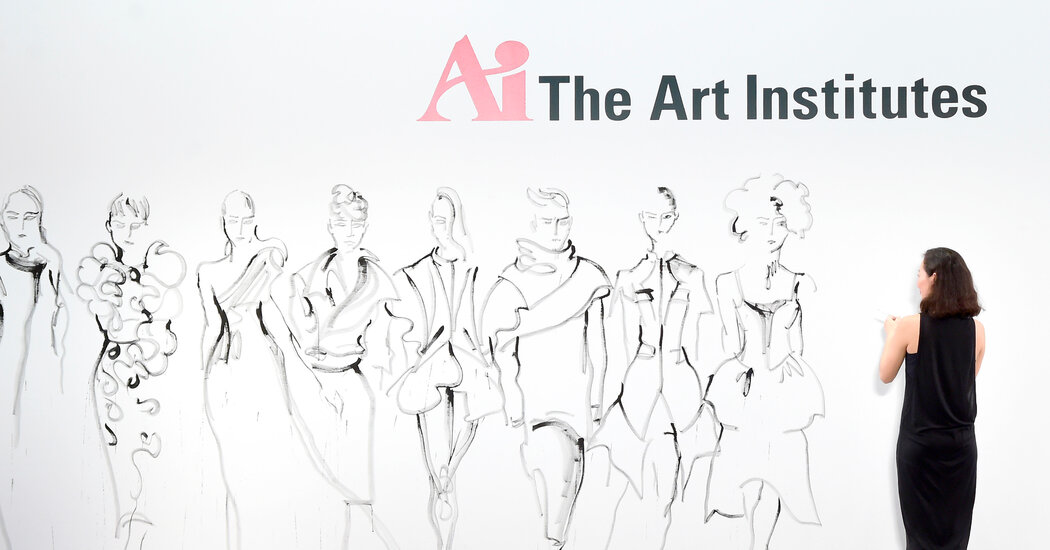Hundreds of students and faculty members were left stunned on Friday by the news that the Art Institutes, a system of for-profit colleges, would close its eight remaining campuses across the United States by the end of this month.
The system had suffered from low enrollment since the coronavirus pandemic began. Previous challenges included a $95 million settlement after fraud allegations in 2015 and a loss of accreditation that led to the shuttering of nearly 20 other locations in 2018.
When Hannah Grabhorn, 21, a sophomore studying games, art and design at the Art Institute of Atlanta, received an email on Friday that said her school was closing, she looked for more answers online. But every page on the school’s website referred her back to the same notice. The email said that “the Art Institutes do not anticipate any further communication.”
Grabhorn said she and her classmates were informed of the closure one day after final exams for the school’s summer quarter.
“All of us were crying,” she said.
The Department of Education said 1,700 students would be affected by the decision. In addition to Atlanta, campuses are closing in Austin, Texas; Dallas; Houston; Miami; San Antonio; Tampa, Fla.; and Virginia Beach.
The Art Institutes did not respond to emails and phone requests for comment.
“There are students who thought they were pursuing an education who are now going to be left out in the cold,” said Deborah Obalil, executive director of the Association of Independent Colleges of Art and Design, a nonprofit consortium.
Traditional models of arts education have experienced contractions, Obalil said. Some schools, such as the San Francisco Art Institute, are declaring bankruptcy, while others, like the Watkins College of Art in Nashville, are merging with larger institutions to save themselves.
“We are at an inflection point,” Obalil said. “Delivering an arts and design curriculum is an expensive operation.”
The Art Institutes were often marketed as cheaper options, with some students saying they were quoted about $90,000 for a full degree’s tuition. One year of tuition at a prestigious alternative like the Rhode Island School of Design is about $58,700.
Experts said that federal rules requiring educational institutions to provide students with a “teach-out” plan for completing their degrees after a closure might not apply to for-profit schools. The Education Department has proposed a rule change to include for-profit schools in the guidelines, but the policy would not go into effect until July 2024.
“We are committed to supporting students as they explore options to continue their education or apply for a closed school loan discharge,” the department said in a statement. “We are working to post information as soon as possible.”
Teachers at the Art Institutes were also surprised by the news.
Anne Perry, an instructor at the Art Institute of Dallas, posted on Facebook that she would “grieve over its fate,” calling the school “a creative, life-giving place to work.”
“I got the message right after I had met on Zoom with a student, and we had expressed looking forward to next quarter,” Perry wrote, adding, “Now it will be a different road, for many.”
Sara Perez Sanders enrolled her daughter, Justice, at the Art Institute of Virginia Beach after Justice earned a scholarship that paid for half of the tuition. She covered the rest with money from the G.I. Bill of Rights, which began offering expanded education benefits in 2009.
“I though it was a hoax,” she said of the school’s closure. “I told my daughter to call her adviser, but the phone lines were disconnected. She was in the middle of uploading her last assignments.”
The school network traces its history back to the Art Institute of Pittsburgh, which was founded in 1921. A Pennsylvania company named Education Management Corporation acquired the college in 1970 before expanding its portfolio and adding courses such as culinary arts, fashion design, audio production and video games. By 2010, the company made $2.5 billion annually, with $1.8 billion coming from Education Department grants and student loans.
Five years later, Education Management Corporation settled claims with the Justice Department about illegal recruiting, consumer fraud and other claims.
Problems only grew after a faith-based nonprofit called Dream Center Education Holdings acquired the schools in 2017. After settling a class-action lawsuit that said that four Art Institutes were misleading students into believing they were accredited institutions, all that remained of the brand was a handful of campuses.
Grabhorn, the student at the Art Institute of Atlanta, said she was in a better position than those of her peers who needed only one more quarter of school before graduating. She has a couple of months before most schools begin their spring semesters to plan her next steps. Her teachers are also looking for new jobs.
“I immediately messaged my professor, who said he was really shocked,” she said. “He asked for a testimonial.”
